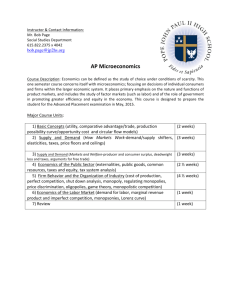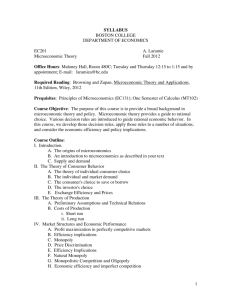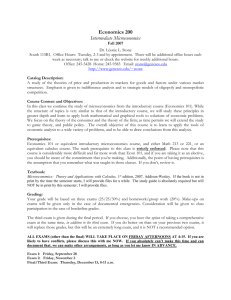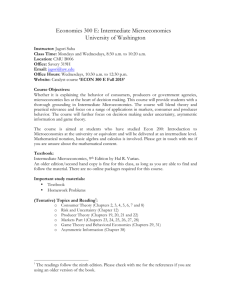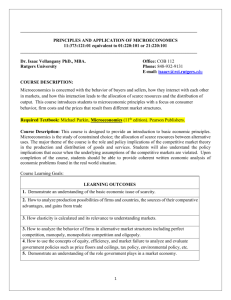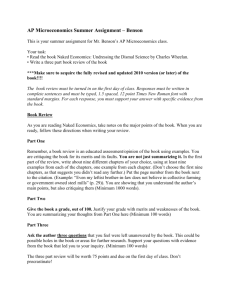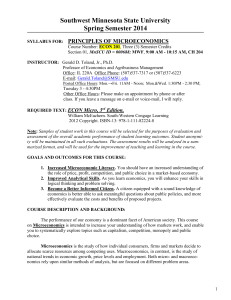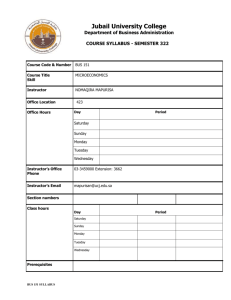Principles of Microeconomics
advertisement
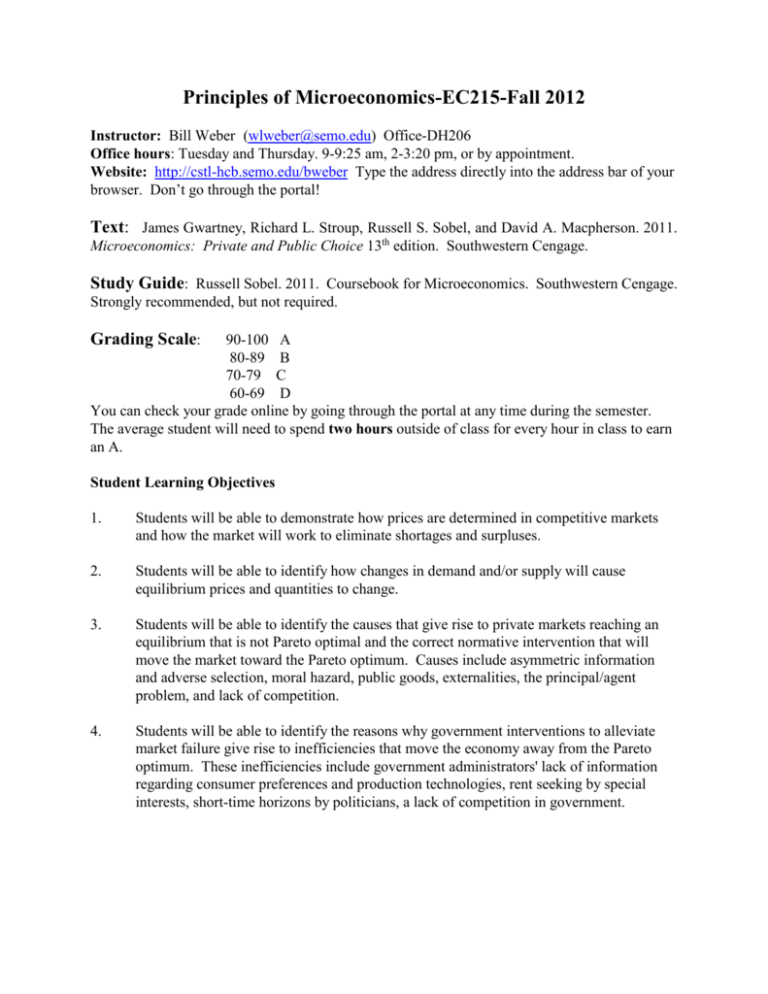
Principles of Microeconomics-EC215-Fall 2012 Instructor: Bill Weber (wlweber@semo.edu) Office-DH206 Office hours: Tuesday and Thursday. 9-9:25 am, 2-3:20 pm, or by appointment. Website: http://cstl-hcb.semo.edu/bweber Type the address directly into the address bar of your browser. Don’t go through the portal! Text: James Gwartney, Richard L. Stroup, Russell S. Sobel, and David A. Macpherson. 2011. Microeconomics: Private and Public Choice 13th edition. Southwestern Cengage. Study Guide: Russell Sobel. 2011. Coursebook for Microeconomics. Southwestern Cengage. Strongly recommended, but not required. Grading Scale: 90-100 A 80-89 B 70-79 C 60-69 D You can check your grade online by going through the portal at any time during the semester. The average student will need to spend two hours outside of class for every hour in class to earn an A. Student Learning Objectives 1. Students will be able to demonstrate how prices are determined in competitive markets and how the market will work to eliminate shortages and surpluses. 2. Students will be able to identify how changes in demand and/or supply will cause equilibrium prices and quantities to change. 3. Students will be able to identify the causes that give rise to private markets reaching an equilibrium that is not Pareto optimal and the correct normative intervention that will move the market toward the Pareto optimum. Causes include asymmetric information and adverse selection, moral hazard, public goods, externalities, the principal/agent problem, and lack of competition. 4. Students will be able to identify the reasons why government interventions to alleviate market failure give rise to inefficiencies that move the economy away from the Pareto optimum. These inefficiencies include government administrators' lack of information regarding consumer preferences and production technologies, rent seeking by special interests, short-time horizons by politicians, a lack of competition in government. Course Introduction: The importance of how we choose to organize our society cannot be overstated. We can choose to promote unabashed political and economic freedom, or we can choose to impose controls upon the economy to protect us from ourselves. All choices have consequences though, and although some of the consequences are unintended, they are not necessarily unpredictable. In this course we will examine how the institutions of markets and government command and control are used to create social order and well-being. Economics is about how we choose to use our limited (scarce) resources. The choices we make today affect the costs and benefits of all citizens today and into the future. While the 1990s generated huge economic gains increasing the quality of life in the US, it has not always been the case in this country and has never been the case for a majority of the worlds citizens. Since your generation is next, it is your responsibility to understand and act upon the economic ideas that can increase the well-being of future generations and to reject those ideas that can harm future generations. In this course we will construct models to try and answer questions about how various policies might affect us. Economist Megan McArdle writes "Models and thought experiments are designed to illuminate principles, not mirror the real world. We already have something that looks and works exactly like the actual world: that is, the world. However, if you want to learn much about that world beyond 'Water is wet' and 'Fire burns,' you need to simplify in order to see deep truths more clearly." One of the key tools we will use is marginal analysis: comparing the costs and benefits of any action. A key to understanding marginal analysis is recognizing that "People respond to incentives." We will examine how markets work and how they sometimes fail. We will also examine various government policy prescriptions for dealing with market failure. Sometimes government fails to improve upon market outcomes. We will check this potential failure out too! Course requirements: There will be three semester exams and a final exam. You may drop your lowest semester exam but not the final exam. Each exam is worth 100 points for a total of 300 points. We will also have about 5 ten-minute 10 point quizzes. In addition, you will complete five or six writing/computer assignments that will be worth 75 points. These writing assignments will sometimes involve the use of EXCEL to analyze data or present a graph. The writing assignments will typically be one to two typed pages and will sometimes involve reading a short article and writing an essay about the economic concept or concepts that are relevant. Total possible points (tentative) = 300 + 50 + 75 = 425. The time to start caring about your grade is today. Please don’t email me telling me that you have to pass the class and that you need extra credit to keep your scholarship, student loan, athletic eligibility, etc. If I “give” you a grade then I am penalizing another student who does not have a scholarship. Start working today! Student responsibilities: You are responsible for what is covered in class and the assigned readings including any reading that is not covered in class. There are two pre-requisites for this class: College Algebra and BA100 or AD101 or some substitute. We will use knowledge from those classes in microeconomics. Classroom etiquette: Coming late to class, leaving early, or walking in and out of class imposes a cost on other students. Please arrive on time, dont leave early, and take care of your business before you come to class so that you dont impose costs on others. Cell-phones, pagers, watch alarms, etc. should be turned off before class. Emergencies happen, but not on a regular basis. If you are a person who needs to leave class or arrive late on a regular basis you should drop this class and find a professor who does not mind students imposing costs on others. Calculator policy: You may use calculators on the tests and during class. Cell-phones are not allowed as a substitute for calculators. Last day to drop a class: Friday November 16, 2012. Tentative Course Outline: Weeks 1-4 Introduction to economics, scarcity, opportunity cost, property rights, production possibilities frontier, principle of comparative advantage, supply and demand, price controls. Chapters 1, 2, 3, 4. There are study questions at the end of the chapter. Exam. September 11, 2012 Weeks 5-8. Difficult cases for the market, collective action, elasticity, Consumer theory (demand), consumer surplus, economic efficiency Chapters 5, 6, and 7. Exam. Weeks 9-11. Perfect competition, imperfect competition, monopoly, public policy toward monopoly. Market structures. Chapters 8, 9, 11, and Special topic Ch. 8 (starts on p. 448). Exam. Weeks 12-15. Resource markets, Labor markets, productivity. Special topic Ch. 11 (starts on p. 478) Final Exam: Thursday December 13, 2012 at 8am.
